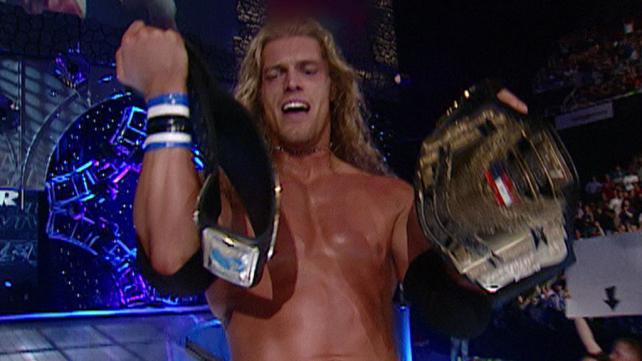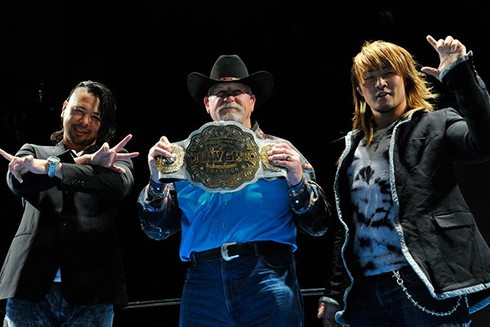
Ultimo Dragon with the short-lived J-Crown Unified Championship, a collection of junior heavyweight titles from across the world. Stuntastic. (Source)
Pro wrestling is a weird bastard art, and if you’re unfamiliar with its intricacies, the hordes of people in your social media circles obsessively pontificating about it every Monday night must be a truly confounding experience. Let our very own Dominic Griffin, lifelong wrestling enthusiast, teach you a little something right here, In This Very Ring…
The other night on Twitter, our very own David Lebovitz had a question about what the purpose of WWE’s United States Championship was. Friend of Old Deadshirt Niel Jacoby and I had to answer him with the only truth there is, which is that the US Championship, in its current form, serves no purpose. None, whatsoever. This is not how it always was.
The WWE currently has five championships: the WWE World Heavyweight Championship, the Intercontinental Championship, the US Championship, the WWE Divas Championship, and the WWE World Tag Team Championship. The Heavyweight, Divas and Tag titles are easy enough to understand, as separate championships for top contenders, women, and teams is a straightforward concept. The secondary titles, like the IC and US, take a little more explanation.
The basic structure of championship divisions in a large wrestling promotion necessitates a tiered title structure. Most indies can get by with a “world” title and a tag title because their roster is small enough for some guys to open the show, others to have personal grudges, and the top guys to battle for the big prize. In larger organizations, you have a wider cast and if you’re not big enough to go after the top title and you’re not engaged in any feuds, there’s nothing for you to do. Midcard titles are ideal stepping stones for up and comers to get to hold the gold and make their way up the ladder. Or they used to be, anyway.
The source of the WWE’s current title problem, as with many things, can be traced back to 2001’s failed Invasion angle that took place after Vince McMahon’s purchase of rival WCW. Played out like a really shitty version of Kurt Busiek and George Perez’s JLA vs Avengers, in which stars from both companies were suddenly inhabiting the same space, as were their totems of power, their championships. Instead of the Infinity Gauntlet and an Oan power battery, you had the (then) WWF Championship and the WCW Championship (represented by the legendary Big Gold Belt that symbolizes excellence across all media platforms).

Green Bay QB Aaron Rodgers with the universal symbol of excellence. No, I’m not talking about the fucking trophy. (Source)
Imagine if DC and Marvel’s crossover was permanent. Forever. Captain America and Superman living in the same universe. What would that do to the power structure of these totems? Would the Cosmic Cube still matter as much? Which characters would lose prominence when suddenly juxtaposed against their rival counterparts? Some things would be conflated together and others would be jettisoned entirely. It’d be fucked up, right? That’s pretty much what happened.
The two world championships were unified together into the Undisputed Championship, by Chris Jericho, which made a lot of sense. Having two world champions running around just wasn’t logical, especially since Vince refused to treat the WCW World Championship like it was a real thing. Better to have one super title than one real one and another ridiculed one. The real problem comes from what happened to the midcard titles.
The Intercontinental and United States Championships once existed as near equals. In the WWE, holding the IC title meant you were the number two guy in the company. While the biggest box office drawer would normally hold the top title, the company workhorse would hold the IC. Guys like Mr. Perfect, Rick Steamboat, Shawn Michaels, they’d hold the title with pride and defend it against other midcarders in classic matches. It wasn’t the big belt, but it meant something. Over in WCW, the US title was used similarly, held by guys like Lex Luger, Sting and a pre-“Stone Cold” Steve Austin. When the companies merged, the two titles were unified with superstar Edge.
Then the brand split happened.
With a massive roster and only one company, Vince split the WWE between Raw and Smackdown, two separate rosters that existed as solitary entities. This meant that they needed to have an additional world title, as one champion splitting his time between two shows proved difficult. As a result, the Big Gold Belt was brought back as the Raw-only World Heavyweight Championship, which stood equally to the WWE Championship on Smackdown. The US Championship was also brought back, to be the midcard title for Smackdown, while Raw kept the IC. All the titles would shift and swap between the shows whenever the annual draft happened, and superstars would get traded, along with their titles.
A new hierarchy began to form. The IC and US remained relatively equal, but the two world titles would not. Eventually, the WHC stuck around on Smackdown and became the “other” world title, because it didn’t represent the flagship program. Superstars like CM Punk, Jeff Hardy and Jack Swagger were given this title first when they reached the main event because being the top guy on Smackdown was like an audition to eventually do the same on Raw. On Smackdown, a program ran for awhile by Paul Heyman, actual wrestling matches and coherent booking were a constant, so, in a way, the essence of what the IC title was in the late 80s/early 90s had transferred to the WHC. It became the new number two slot, leaving the IC and US titles, now being booked as needless accessories, in some sort of relevancy purgatory.
Third generation superstar Cody Rhodes tried to bring some prestige back to the once beloved title a few years ago, when he ponied up his own money for a throwback title modeled after the white strap worn by the likes of Shawn Michaels in the championship’s prime. A cosmetic change that excited longtime fans, Cody’s efforts weren’t enough to overcome the stagnation that now surrounds the midcard title. It used to be that winning the IC or US title meant you were the king of a smaller mountain, where you would defend the title vigorously and treat it like a real accomplishment. Nowadays, the IC and US champions lose non-title matches and get pinned by the “real” champion all the time. Now that the WWE and WHC titles have been (again) unified in the post-brand split era, it should be even easier to make the midcard titles matter again, but the creative team is just not doing it.
In WCW, when there were multiple singles titles, each served a different purpose. The US title was like a number one contender trophy. The Television title was primarily defended on WCW’s television programming. The Cruiserweight title was only for junior heavyweights. There was logic and form to the hierarchy. Nothing divides the IC and US titles. They’re equally misused hunks of metal attached to leather straps, pointless garments that shine in the light.
Currently, Bad News Barrett, the reigning IC champ, has vacated the title due to injury. A new champion will be chosen in a battle royale at Battleground this weekend. Current US champ Sheamus is one of the contenders, which means we could see the two titles unified. Theoretically, that would solve some of the problem, but if Sheamus holds both titles but continues to not defend them in meaningful, memorable feuds, nothing will change. For inspiration, I hope the WWE takes a cue from New Japan Pro Wrestling.
New Japan invented the IWGP Intercontinental Championship a few years ago as a midcard stepping stone title modeled after its WWE equivalent. Nobody really gave a fuck about it until Shinsuke Nakamura won it and began defending it all over the place. Having one of the most popular wrestlers on the roster holding this title lent it some serious prestige. What blew it up supernova style was Nakamura dropping it to long time rival/NJPW Ace Hiroshi Tanahashi, in the main event of Wrestle Kingdom 8 (NJPW’s Wrestlemania), no less.
Imagine if the WWE had John Cena and Randy Orton feuding over the IC belt. People would complain that two main eventers were hogging a midcard belt, but if Randy won the feud and then put over younger talent by dropping the title to someone in need, imagine what it would do for the championship.
Nakamura won the IWGP IC title back from Tanahashi, cementing his dominance. The matches they had over this belt were some of their best. When Nakamura recently lost the belt to King Fale, the Bullet Club’s inexperienced heavy, it was a real accomplishment for the rookie. Nakamura and Tanahashi elevated the fuck out of that title and it only took like six months and two guys.
Why? Because the belt doesn’t make the man. The man makes the belt.
WWE should remember that.
Follow @DeadshirtDotNet and @captain_fuck on Twitter where we’ll be available to answer any possible question you could have about wrestling.




